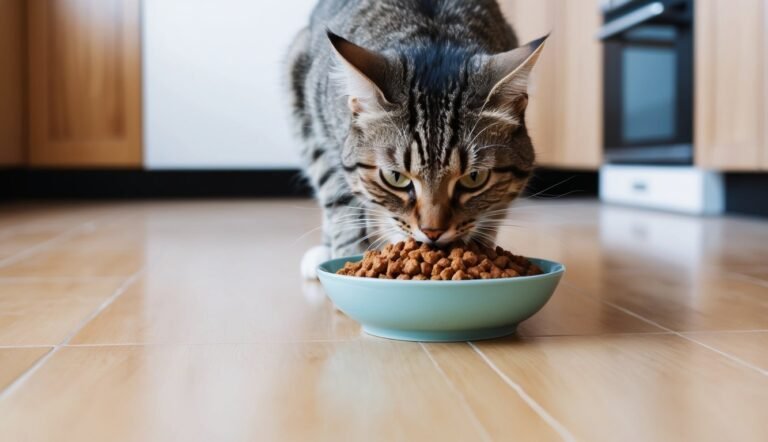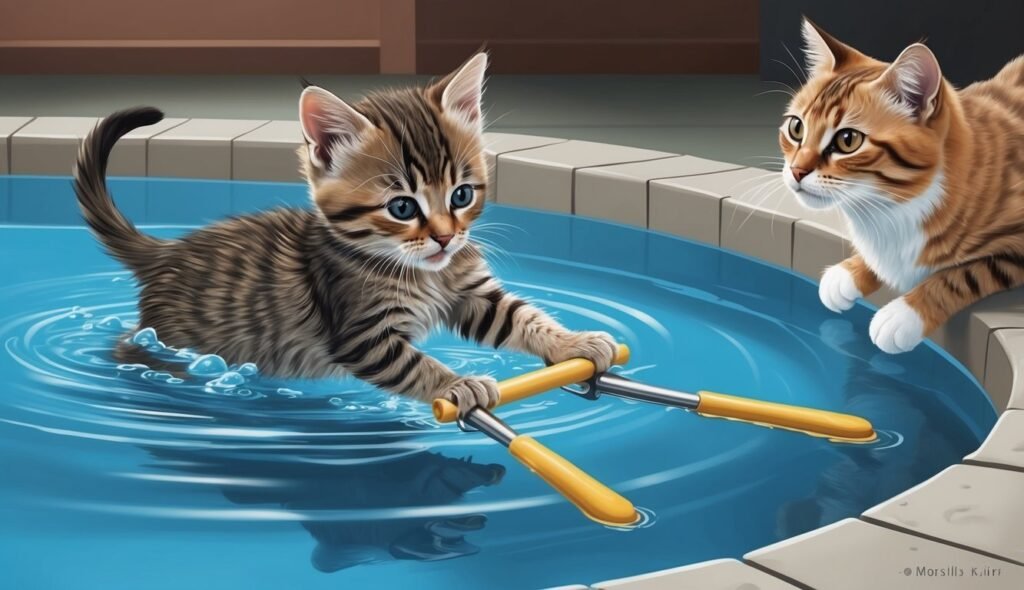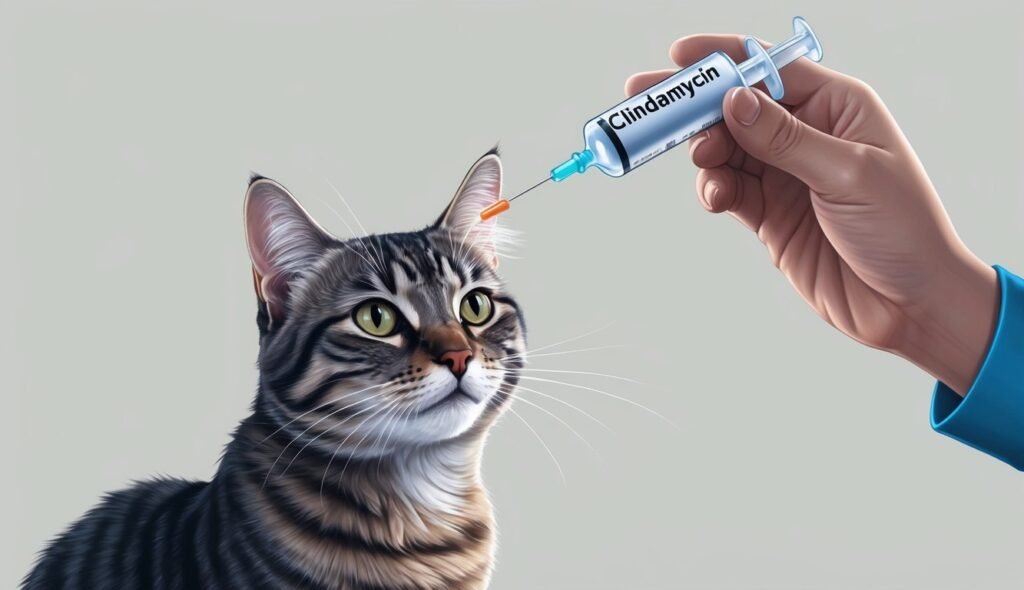Cats have unique dietary needs that set them apart from other pets.
Providing real food for your cat means focusing on high-quality proteins that cater to their status as obligate carnivores.
A diet rich in essential nutrients can lead to improved health, better skin, and shinier coats, contributing to a happier feline.
Navigating the world of cat food can be overwhelming with so many options available.
From homemade recipes to commercially prepared human-grade foods, understanding what truly constitutes a nutritious meal for your cat is essential.
Exploring the best practices for feeding your pet ensures that you’re making informed decisions that benefit their long-term health and well-being.
As you dive deeper into this topic, familiarize yourself with the signs of a truly balanced diet and how to maintain your cat’s interest in their meals.
By knowing what your cat genuinely needs, you can become a more effective caregiver and ensure your feline friend thrives.
Key Takeaways
- Real food focuses on high-quality protein essential for feline health.
- Understanding cat nutrition is vital for maintaining a balanced diet.
- Feeding strategies can help keep picky eaters engaged with their meals.
Understanding Cat Nutrition
Understanding cat nutrition is essential for ensuring your feline friend thrives.
Knowing their specific dietary needs can help you choose the best foods that support their health and well-being.
Nutritional Needs of Obligate Carnivores
Cats are obligate carnivores, meaning their diet is primarily based on animal-derived nutrients.
Unlike some pets, cats cannot thrive on a vegetarian diet.
They have a high protein requirement and need nutrients that can only be found in animal tissues.
Key components include:
- Taurine: An essential amino acid found in animal products, crucial for heart health and vision.
- Fatty Acids: Omega-3 and omega-6 fatty acids promote skin health and reduce inflammation.
When selecting food, look for those that meet AAFCO standards to ensure nutritional adequacy, especially for all life stages.
Essential Nutrients for Feline Health
A balanced cat diet hinges on several essential nutrients that play pivotal roles in their health.
- Proteins: Vital for growth and repair.
- Vitamins: Particularly Vitamin A, which is necessary for vision, immune function, and reproduction.
- Minerals: Include calcium, phosphorus, potassium, and magnesium for bone health and bodily functions.
High-protein cat food that contains digestible protein helps maintain optimal health.
Keep in mind the need for additional nutrients like vitamins and minerals to create a well-rounded diet.
Protein: The Core of a Cat’s Diet
Protein should be the foundation of your cat’s diet.
It supports their muscle maintenance, immune function, and overall energy levels.
Look for formulas that list real meat as the first ingredient.
A typical breakdown might be:
- Animal Protein: 30-50%
- Fat: 15-25%
- Carbohydrates: Under 10%
Foods high in protein not only assist in maintaining muscle mass but also provide stimulating flavors that cats enjoy.
Always consult an animal nutritionist when transitioning diets to ensure balance and adequacy, especially for specific health conditions.
Types of Cat Food
When selecting the right type of cat food, you’ll encounter various options that cater to your cat’s nutritional needs.
Understanding the differences between these types helps you make an informed decision for your feline friend.
Wet vs. Dry Cat Food: Pros and Cons
Wet and dry cat foods each come with their advantages and disadvantages.
Wet cat food typically has a higher moisture content, which can promote better hydration.
It’s often more palatable for cats, especially those with dental issues or older cats lacking appetite.
Many wet foods also include higher protein content, which is crucial for your cat’s health.
On the other hand, dry cat food is more convenient to store and often more cost-effective.
It can also help maintain dental health by reducing tartar buildup.
However, it generally contains less moisture, which might not be ideal for cats that aren’t good at drinking water.
Consider your cat’s preferences and health needs when choosing between these two options.
Benefits of Fresh, Human-Grade Cat Food
Fresh, human-grade cat food is becoming increasingly popular among pet owners.
This type of food typically features high-quality ingredients that you might find in your meals, such as fresh meats and vegetables.
It’s often minimally processed, which helps retain nutrients.
One significant benefit of fresh cat food is its appeal to picky eaters.
Cats tend to favor food that smells and looks appetizing, and fresh meals often check those boxes.
Additionally, brands offering human-grade options often avoid fillers and artificial additives, which can lead to better health outcomes for your cat.
The Debate on Grain-Free Diets for Cats
Grain-free diets are a hot topic in the cat food world.
Proponents claim that cats, being obligate carnivores, thrive on high protein and low carbohydrate diets.
Grain-free cat food often substitutes grains with ingredients like peas or potatoes, which may be easier for some cats to digest.
However, not all experts agree on the necessity of grain-free diets.
Some studies suggest that certain cats may not benefit from this type of food and could even develop nutritional imbalances.
Balancing your cat’s diet while ensuring they receive all necessary nutrients is crucial, so consult your veterinarian before making any significant diet changes.
Exploring Raw Food Diets
Raw food diets for cats aim to mimic what they would eat in the wild.
These diets typically consist of raw meats, bones, and organs.
Advocates argue that this can improve coat quality and energy levels, as well as lead to a healthier weight.
There are various approaches to feeding raw, including commercially prepared raw meals and homemade options.
However, it’s important to handle raw food safely to prevent contamination.
Consult a veterinarian to ensure that any raw diet is balanced and meets all of your cat’s nutritional requirements.
Best Practices for Feeding Your Cat
Feeding your cat involves understanding their unique nutritional needs.
Focus on deciphering food labels, ensuring a balanced macronutrient profile, and determining the right portion sizes and feeding frequency.
Decoding the AAFCO Statement
When choosing cat food, check the AAFCO statement on the packaging.
This statement indicates that the food meets the nutritional standards set for cats.
Look for phrases like “complete and balanced” to confirm that the food provides essential nutrients your cat needs.
The AAFCO guidelines ensure your cat receives adequate protein, fats, vitamins, and minerals.
If you opt for homemade food or human foods, consult with a veterinarian to ensure proper nutrient balance.
Ideal Macronutrient Distribution
Cats are obligate carnivores, which means they require a diet rich in animal-based proteins.
Aim for a macronutrient distribution of:
- Protein: 30-50%
- Fat: 20-30%
- Carbohydrates: Low, ideally below 10%
Include sources of omega-3 fatty acids, found in fish oils, to support skin and coat health.
Be cautious of high carbohydrate content, as cats do not process carbs efficiently.
A balanced diet ensures your cat maintains a healthy weight and energy levels.
Portion Sizes and Frequency
Determining portion sizes is essential for maintaining your cat’s health.
Most adult cats thrive on two meals per day.
Adjust portion sizes based on your cat’s weight, age, and activity level.
A general guide is around 20 calories per pound of body weight.
For example, if your cat weighs 10 pounds, aim for about 200 calories daily.
Use a measuring cup to ensure accuracy.
Pay attention to caloric density; higher-density foods require less volume.
Monitor your cat’s weight regularly and consult with a vet if you notice significant changes.
This approach helps prevent obesity, which is increasingly common among domestic cats.
Specialized Diets for Cats
Every cat has unique dietary needs based on their life stage and health.
Understanding these specialized diets can help you make informed choices for your feline friend.
Formulating a Kitten’s Diet
Kittens require a diet rich in protein and fat to support their rapid growth.
Look for kitten food specifically formulated with animal-based ingredients like chicken, turkey, or fish.
Key nutrients include:
- Protein: Essential for muscle development.
- DHA: Supports brain development, often found in fish oil.
- Calcium and Phosphorus: Necessary for bone growth.
Choose high-quality brands that offer wet and dry options to keep things interesting.
Wet food provides hydration, while dry food can help with dental health.
Ensure that the kibble is small enough for your kitten to chew easily.
Managing Sensitive Stomachs
If your cat has a sensitive stomach, focus on easily digestible ingredients.
Limited-ingredient cat food can be a good choice, as it reduces the number of allergens in your cat’s diet.
Look for:
- Real animal protein as the first ingredient.
- Grain-free diets to minimize digestive issues.
Incorporating fiber sources like pumpkin can help with digestion.
Avoid foods with artificial additives, which can upset sensitive stomachs.
Always transition to new foods gradually to prevent digestive upsets.
Feeding Indoor vs. Outdoor Cats
Indoor cats typically require fewer calories than outdoor cats since they tend to be less active.
Look for indoor cat food formulated to support a healthy weight while providing essential nutrients.
Consider these factors:
- Caloric Density: Indoor formulas often have fewer calories per serving.
- Fiber Content: Higher fiber helps prevent hairballs.
For outdoor cats, choose a diet that supports their energy needs.
They may benefit from higher protein levels to maintain their activity levels.
If your cat is a picky eater, you might need to try different brands until you find one they love.
Nutrition for Senior Cats
As cats age, their nutritional needs change.
Senior cat food is typically lower in calories, high in fiber, and enriched with antioxidants to support overall health.
Key nutrients include:
- High-quality protein for muscle maintenance.
- Omega fatty acids for joint health.
- Digestive aids like probiotics to support gut health.
Look for food designed specifically for seniors; these often have added moisture content if your older cat struggles with hydration.
Choosing the Right Cat Food Brand
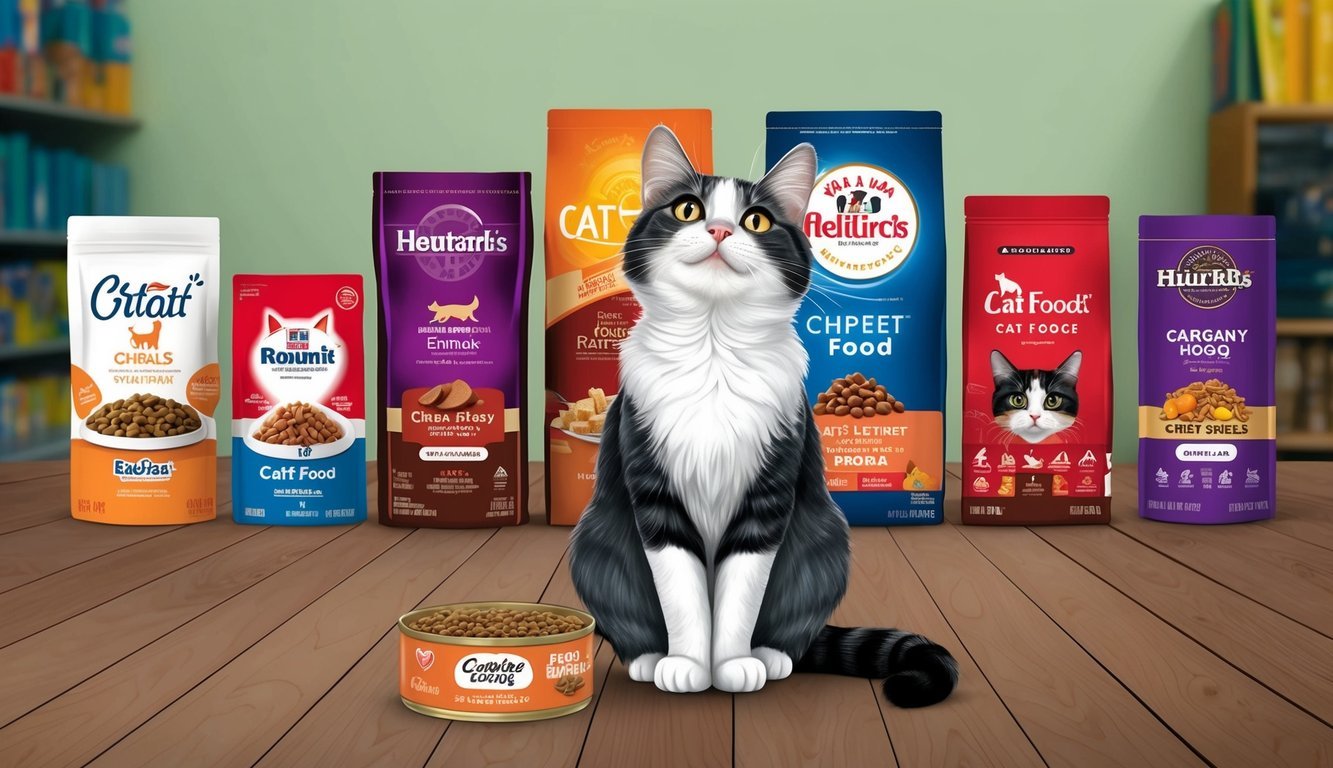
Selecting the right cat food brand is crucial for your pet’s health and well-being.
You want to ensure the food provides quality nutrition that suits your cat’s specific needs.
Here’s what to look for on the label and some of the top-rated brands available.
What to Look for in a Cat Food Label
When examining a cat food label, focus on the first ingredient.
High-quality brands often list a specific meat source, like chicken or turkey, as the first item.
Avoid foods with generic terms like “meat by-products.”
Check for protein content—a minimum of 30% is generally a good benchmark for adult cats.
Look for fat content too; ideally, it should be between 15-25%.
Ingredients like fish oil or chicken fat are good sources.
Also, avoid fillers such as corn and soy, which provide little nutritional value.
Lastly, consider added nutrients like probiotics or vitamins.
Brands like Hill’s Science Diet often include these beneficial ingredients.
Top Rated Cat Food Brands
Here are some of the top-rated cat food brands to consider:
| Brand | Key Features |
|---|---|
| Hill’s Science Diet | Vet-recommended; balanced nutrition for various life stages. |
| Smalls Human-Grade Fresh Cat Food | Fresh, human-grade ingredients; great for picky eaters seeking variety. |
| Purina One | Affordable; offers a variety of recipes targeting specific needs. |
| Friskies | Widely available; fun flavors and textures for cats. |
These brands consistently receive high ratings from cat owners and veterinarians alike.
Always ensure the chosen food meets your cat’s unique needs, taking age and health status into account.
Feeding Strategies for Fussy Felines
Dealing with a picky cat can be challenging, but there are strategies that can help you encourage better eating habits.
Knowing how to entice your feline friend and when to rethink their food choices is essential for maintaining their health.
Tips to Entice a Picky Eater
-
Meal Variety: Cats can be creatures of habit, but introducing variety in their diet can pique their interest. Try different flavors, like chicken, turkey, or fish.
Offer both wet and dry foods, as many cats prefer the moisture in wet food.
-
Temperature Matters: Cats often enjoy their food warmed to body temperature. Warming food can enhance its aroma and make it more appealing. Just be cautious not to overheat it.
-
Feeding Schedule: Instead of leaving food out all day, establish specific mealtime routines. Feeding twice a day can create anticipation and routine, making your cat more likely to eat.
-
Appeal to Instincts: Use shallow, wide bowls to encourage your cat to eat comfortably. Some cats prefer certain placements, so experiment with different spots in your home.
A quiet, low-traffic area can also help them relax during meals.
When to Consider Switching Foods
If your cat continues to refuse food, it might be time to assess their current diet.
Here are several signs that indicate a food switch may be necessary:
-
Lack of Interest: If your cat consistently ignores their food, it may be a sign that the flavor or texture isn’t appealing.
-
Health Issues: Consult your vet if your picky eater shows signs of lethargy, weight loss, or other concerning symptoms. These issues may require a more specialized diet.
-
Allergies or Sensitivities: Some cats can develop allergies or food sensitivities over time. Keep an eye out for any digestive upset or skin issues.
Switching to a high-quality, limited-ingredient food could help ease their symptoms.
Selecting the best cat foods involves checking for high-quality ingredients and considering your cat’s specific needs.
Always transition slowly to minimize digestive upset when introducing new foods.
Frequently Asked Questions
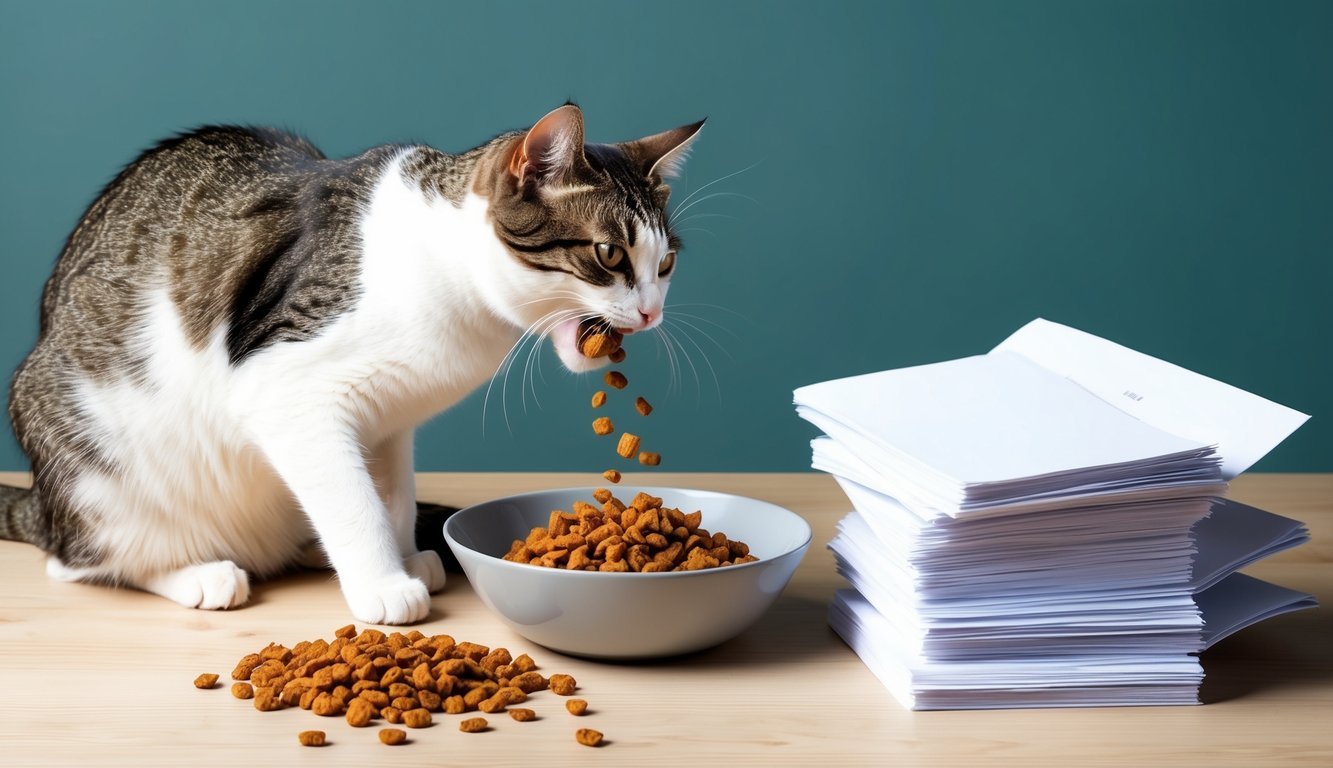
When considering fresh food for your cat, you might have several questions about the benefits, safety, and preparation involved.
Here are some common inquiries that can guide you in making informed decisions.
What are the benefits of feeding my cat fresh food?
Feeding your cat fresh food can lead to improved digestion, better skin and coat health, and increased energy levels.
Many pet owners notice a reduction in waste volume and smell as well.
Fresh ingredients often provide higher nutrient content compared to processed foods.
How do I know if a cat food is truly human-grade?
To determine if a cat food is human-grade, look for certification or labeling on the packaging.
Human-grade foods are made with quality ingredients that are safe for human consumption.
Researching the brand’s sourcing practices can also help ensure the food meets these standards.
Could I prepare homemade cat food, and how do I start?
Yes, you can prepare homemade cat food.
Start by researching balanced recipes that meet your cat’s nutritional needs.
Consulting with a veterinarian or a pet nutritionist can help you ensure the meals you create are safe and nutritious.
Where can I find reviews for cat food brands like Smalls?
You can find reviews for brands like Smalls on pet food review websites, forums, and social media groups dedicated to pet care.
Customer feedback on platforms like Amazon and Chewy can also provide insight into the quality and palatability of the food.
What should I consider when choosing a commercial raw food diet for my cat?
When choosing a commercial raw food diet, check the ingredient list for high-quality proteins and fats.
Look for brands that use ethically sourced ingredients and have transparent manufacturing practices.
Additionally, ensure the food adheres to AAFCO guidelines for balanced nutrition.
Can I feed my cat a combination of commercial and homemade foods?
Yes, you can combine commercial and homemade foods.
Just make sure that both types of food provide balanced nutrition.
Monitor your cat’s health and adjust portions accordingly to prevent overfeeding.
Regular veterinary check-ups can help keep track of your cat’s nutritional needs.

